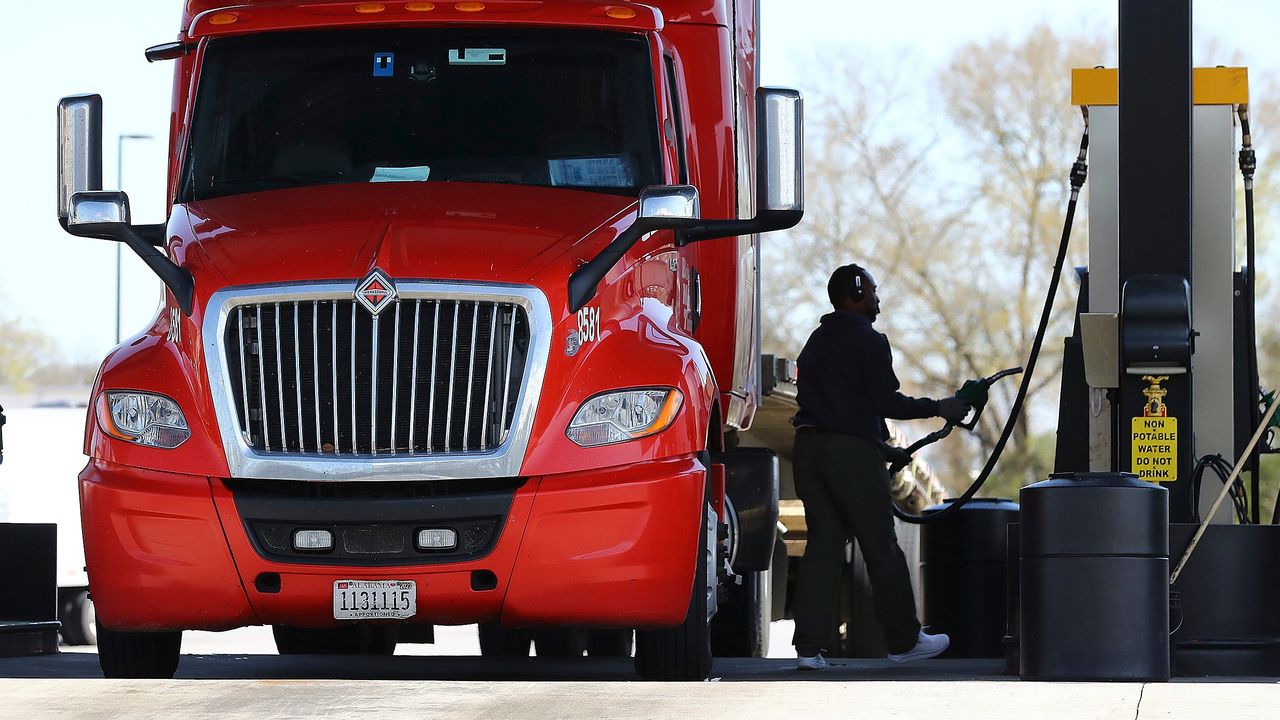Truck Driver Salary: How Much Does a Truck Driver Make? The days of truck driver being hidden superheroes who keep the world operating smoothly are long gone. With persistent supply chain bottlenecks, trucking has become a very visible and prominent vocation across North America. If you’re thinking about becoming a truck driver but are stumped by the question “How much does a truck driver make?” this post is for you.
We’ll look at the socioeconomic importance of trucking and logistics, as well as how each affects drivers’ take-home compensation. Continue reading to learn about truck driver salary range in the United States according to geography, routes, experience, company size, and vehicle type. How much does a truck driver make? Although some people think that truck drivers make the same amount across the country, the truth is that a number of internal and external factors affect a truck driver salary.
What Factors Influence a Truck Driver Salary?
To begin with, the driver’s location influences their pay. Companies in the West and South generally offer less money than those in other sections of the country. However, regardless of which state they operate in or are located in, the truck driver salary gap for OTR (“over-the-road” or long-haul trucking) carriers is fairly minimal.
The routes you take also affect your truck driver salary. There is usually a salary variation depending on whether you are driving local, regional, or over-the-road routes. OTR drivers earn more than regional drivers since they are gone from home for longer periods of time. Similarly, regional drivers earn more than local drivers since they are typically home on a weekly basis, whereas local drivers are home every day.
Along with location and routes, the type of trailer you use influences the amount of money you receive. Dry van drivers, for example, make less than reefer truckers, who make even less than flatbed drivers. Another key component is the driver’s experience; truckers with little or no experience earn less than those with years of expertise. partly because companies must pay more in insurance when working with novice drivers.
And the size of your organization influences your profits as a driver. If you work for a small firm, your earnings may be greater than those of your contemporaries who work for larger corporations because small businesses are more willing to respond to market conditions and raise driver pay. However, there may be some drawbacks to this positive: larger carriers may have the steadiness of a constant workload and an experienced management team, which smaller, more independent carriers may not be able to provide.
What is the average Truck Driver Salary?

According to Indeed estimates (and bear in mind that estimates are just that—estimates — and may therefore fluctuate from week to week or month to month), the truck driver salary split of a truck driver in the United States is as follows (taking the 11-hour driving restriction into account):
- The hourly rate is $28.05.
- The daily rate is $320.
- Weekly pay is $1,544.00.
- Monthly rent is $5,780.
- Year’s salary of $84,377 is the average.
Other advantages and bonuses may apply based on internal corporate regulations or external reasons such as poor weather or economic fluctuations, increased demand due to supply chain concerns, and so on.
PPM Method (Pay Per Mile)
Most truckers believe that charging for every mile is reasonable compensation for their services. However, the cents per mile (CPM) are determined by the parameters stated above. According to Statista, the median CPM for truckers in 2020 will be $0.57 per mile.
What Are the Different Pay Structures for Truck Drivers?
To start a small or medium-sized trucking and logistics firm, it is critical to understand the various truck drivers’ compensations.
The following are the most frequent pay models for truckers:
1. Hourly wage
The hourly compensation model is typically used for intrastate deliveries if the distance between the pickup and drop locations is less than 150 miles. You may be required to participate in various chores, such as loading and unloading freight and engaging with clients. You must also make stops along the route.
It is sometimes necessary to begin without a fully loaded truck. Performing these additional responsibilities can help drivers earn more money and incentives. Mostly small businesses and supermarket chains use the hourly wage system. To enhance your hourly income, an independent delivery contractor must put in more work and time.
However, whether you are an owner-operator or operate a logistics firm, it is critical to efficiently examine the route plan. Paying your delivery drivers on an hourly basis might raise your operating costs if your routes are inefficient.
2. Pay per mile
This is the most often used model in the trucking sector, and it is also known as CPM, or cents per mile. A driver is compensated for the miles they travel, as the name implies. The per-mile charge varies depending on the company and the kind of product. A corporation can compute mileage pay in a variety of ways.
Mileage on household goods (HHG)
This type of payment is also known as ZIP code miles or short miles. The two places’ primary post offices are identified, and the shortest distance between the two ZIP codes is determined.
Actual mileage
The mileage is computed using the electronic logging device (ELD) aboard the truck. The ELD calculates and displays the route between the two sites to the driver. This gadget will track the distance you go.
Hub distance
It is the real distance that the truck will travel hauling freight. When the voyage begins, the truck’s odometer is logged, and it is checked again when the truck arrives at its destination. The difference is computed, and you are compensated for the miles driven.
3. A set salary
There are very few people in the trucking industry who use the fixed salary payout method. As the name implies, as a driver, you will receive a truck driver salary regardless of the miles, hours, or weight you transport. You will be paid the same amount for the duration of your contract. Fixed-salary positions are scarce in the trucking sector, which benefits both the owner and the drivers.
4. Total Load 4%
This is one of the most commonly employed ways in business since it is useful when transporting precious products or making medium-to-short-distance deliveries. This strategy is most typically used by owner-operators since particular shipments may necessitate more resources than the owner has available. Rather than recruiting new drivers, owners hire freelance drivers or owners and divide the profit according to an agreed-upon percentage.
5. Team Driver Compensation
This truck driver-pay model will employ two drivers rather than one. Team rates are significantly higher than single-driver rates; however, the rate is split among the truck drivers. The team drivers decide how the truck driver salary is divided among themselves. Many drivers say that this approach allows them to make more money and that they are happier sharing the ride with someone. The majority of drivers prefer to work in groups.
The model is commonly utilized for long-distance deliveries. A team of two drivers can cover more ground in less time. This is beneficial to both drivers and owners. Let’s move on to our next issue, which is how drivers are compensated.
Truck Driver Salary by Trailer Type

For commercial trucking, many types of vehicles and trailers are employed. While truck specifications are likely to focus on performance, trailer variances are likely to be around application requirements. Some transport consumer items and farm produce, while others specialize in non-standard delivery, such as hazardous chemicals and natural resources. As a result, some truckers must get specific endorsements to transport these goods. Keeping this in mind, truck drivers’ pay varies depending on the following factors:
Needing Special Approval
A special endorsement is an enhancement to your standard commercial driver’s license (CDL) that permits you to transport specialty loads while earning additional money. Truckers charged with transporting nuclear waste from industries to disposal facilities are one example. These drivers require specific endorsements, which raise their pay. If you’ve ever seen a truck delivering hazardous materials and wondered, “How much do hazmat truck drivers make for putting their lives in danger?””then this is the area for you.
Trucks for Hazmat (H Endorsement)
Hazmat driving costs between $0.60 and $0.80 per mile. In terms of hazmat trucker salary, drivers may earn between $68,750 and $100,000 per year, depending on their weekly workload. To operate such vehicles, you’ll also need a TSA-issued HazMat endorsement, which will enable you to earn a higher salary. Do you wish to learn how to obtain a hazmat endorsement? Please read our article.
Triples/Doubles (T Endorsement)
With this endorsement, you can drive with more than one trailer hitched. These are frequently referred to as “long-combination vehicles,” or LCVs, and this certification is sometimes known as an LCV endorsement. The yearly truck driver salary range for a double trailer truck driver is $62,500 to $93,750. The CPM might increase from 50 to 75.
To obtain a T endorsement, you must pass an extra written knowledge test covering important concerns (such as preventing two or three trailers from rolling over) as well as completely knowing how to pair and decouple trailers effectively. Obtaining an endorsement also opens up options to raise your salary.
Tankers (N Endorsement)
Tank trucks are intended to transfer liquids or liquefied gases in a safe manner. An N endorsement allows you to drive a vehicle with a permanent or temporary tank installed. Drivers in this category require a CDL endorsement other than the standard hazardous endorsement. The typical yearly tanker truck driver salary is $75,000–$106,250 for drivers that accomplish over 2500 miles per week at 60–85 CPM.
Tanker and Hazmat (X Endorsement)
After completing the mandatory knowledge test, the “X” endorsement, commonly known as the Tanker/Hazmat Combo endorsement, permits you to operate tankers and other vehicles carrying hazardous compounds. Because these truckers transport hazardous goods, their pay per mile ranges from $0.60 to $0.85. They also earn between $68,750 and $106,250 every year.
Trucks that do not have a Special Endorsement
Flatbed Truck Driver Salary
The typical salary for a flatbed truck driver is between $80,000 and $90,000 per year. The national average truck driver salary per mile is $0.50–$0.60, resulting in a weekly salary of roughly $1,250–$1,500. However, you should keep in mind that the majority of corporations give tarping bonuses ranging from $200 to $350 every week. If you’re interested in learning more about the benefits and drawbacks of flatbed trucking, be sure to read our other post.
Dry Van Driver Salary
Dry van truckers make between $60,000 and $65,000 per year and $1,200 to $1,300 per week. The typical dry van driver salary in CPM is 48–52, with a daily cost of $250–$270.
Refrigerated Truck Driver Salary
Refrigerated truck drivers (reefers) deliver perishable commodities between states. The average annual truck driver salary for a reefer truck driver is roughly $65,000. A reefer driver earning $0.52 per mile may earn $1,300 in a week.
Oversized Load Truck Driver Salary
You may earn an annual oversize truck driver salary of $118,750 if you haul heavy-duty equipment cross-country, which amounts to around $2,375 per week or $0.95 per mile.
Truck Driver Salary by Operating Mode
Here are the typical business models for truckers:
Salary of a Single Truck Driver
You are a solitary driver when you complete a trip by yourself. Riding alone may be lonely, especially on lengthy journeys. On the plus side, you won’t have to split your money with anyone. According to Ziprecruiter, the average annual truck driver salary for a solitary truck driver is roughly $81/249,000 (gross).
Salary of Team Truck Drivers
Truckers can work in groups rather than alone. You can collaborate with a spouse, friend, or coworker under this operational model. Because you’ll be delivering your freight in half the time it would typically take, team trucking businesses generally outperform solo enterprises. The team drivers’ remuneration per mile for two-person partnerships is roughly $0.75–$0.90 divided.
Although most teams evenly divide expenditures and returns, members might share rewards based on their original efforts. According to Ziprecruiter, the average truck driver salary for team truck drivers is roughly $119,000 per year. If you want to find out if becoming a team truck driver is the perfect job for you, read our article on what team truck driving is.
Owner-Operator Wage
Solo entrepreneurs frequently favor a hands-on approach to the company, functioning as both operators and owners. The obvious disadvantage of this arrangement is that carrying things yourself restricts your capacity to concentrate on administrative responsibilities.
Excluding maintenance costs, the owner-operator salary range for a trucker traveling 500 miles per day is roughly $85K to $100K. Your preferred route, load type, and other factors are largely what determine truck driver salary because you are the direct negotiator for each task.
Salary of a Lease Operator
The typical lease operator salary, according to Indeed, is impossible to establish owing to the significant variance in employment volume and distance covered. Nonetheless, the typical salary ranges between $90,000 and $120,000.
Truck driver Salary based on experience

The more experience you have in the sector, just like in any other business, the more companies are prepared to pay for your skills. Let’s go over how your experience affects your CDL A driver salary.
CDL A Drivers Starting Salary
Every new truck driver must start at the bottom and work their way up. Even if you have a CDL Class A license, you will not be able to make as much as someone with years of expertise in the same area for the same operating model.
In the United States, the average new truck driver salary is $40,000 per year. In small businesses, these newcomers can charge $0.30–$0.40 per mile, while larger enterprises can pay up to $0.50 per mile driven.
Salary for Experienced CDL-A Driver
Experience allows you to have a better knowledge of industry rules. You’ll also learn how to optimize your profits while adhering to municipal, regional, and interstate driving restrictions.
Furthermore, having a demonstrated track record of delivering for several organizations gives you the negotiating power to negotiate better pricing for yourself. In general, experienced drivers have superior commercial driving abilities.
According to market estimates, an experienced truck driver salary might range between $90,000 and $120,000, depending on region, routes, and endorsements. Although the average CPM is 55–75 cents per mile, certain expert drivers may earn $0.85–$0.95 per mile.
Salary Influencing External Factors

The typical CDL A driver’s salary frequently varies within a narrow range. We’ve looked at the primary factors that influence a truck driver’s pay. However, the following external factors can have an impact on the overall payment:
- Border crossing: Waiting at border crossings or customs adds to the overall cost of each task for drivers who are paid on an hourly basis. Although some firms charge extra costs to account for border delays, it is generally insufficient to pay for lost time.
- Traffic: Trucks frequently have a 14-hour window to move between states. However, in cities like California and New York, drivers frequently find themselves idling in traffic for longer than the projected delivery time.
- Safety checks: When you work for a large corporation, agents and supervisors handle the weighing procedures. However, if you operate with a small carrier, you will frequently need to double-check the load before departure and upon arrival, which increases freight time.
- Safety checks: Before embarking on your journey, you must do safety checks (pre-trip inspection) to ensure that the cargo is in ideal condition. Given the severe consequences of any incident, these frequent checks are especially important for hazardous and tanker vehicles. Furthermore, you must make these inspections following any unusual occurrence on the road, such as skidding, crashes, or accidents.
- DOT inspections: DOT officials may need to examine your load before departure and upon arrival. These inspections frequently entail re-weighing the package to ensure that it matches the data on the manifest.
- Unloading and loading: You will accrue time but not necessarily money while waiting for the client to load or unload. This will have an impact on your bottom line because it is still time spent away from home or earning extra while driving.
- Repairs: If your truck has a problem, you may need to stop for repairs. You might receive additional compensation for such incidents if you report them to the boss as soon as they occur.
Other unforeseeable factors might have a major impact on the amount of money you receive for each surgery.
Conclusion
Choosing a trucking firm to work with may be difficult, especially for those just starting out in the industry. Always evaluate the advantages and support system that a carrier provides for its drivers before picking one to work with. Use this information to plan your path and earn as much money as possible. Trucking is the place to work if you want to work for a firm that cares about the driver’s entire health and well-being. Because of our individualized approach to trucking, we are a popular choice for drivers with at least 6 months of CDL A experience. Apply now to begin your trucking journey.


